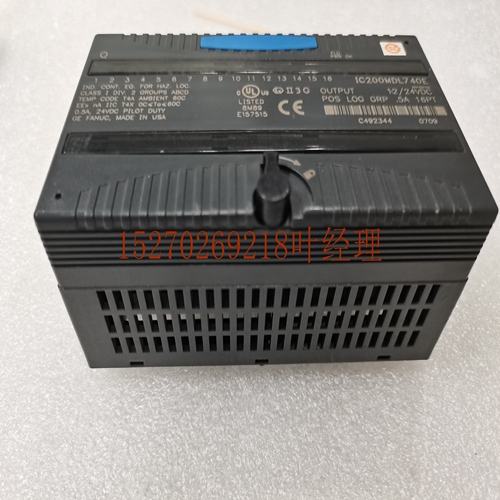IS200TDBSH2AAA,IS210BPPBH2CAA工业自动化卡件
因为输出表决是由控制点的块执行的,所以总线错误由表决过程补偿。离散输出标准“H”模式输出Genius块组为离散输出提供容错控制。输出组由连接到致动器或其他设备一侧的两个平行源型块和连接到另一侧的两两个平行汇型块组成。下图表示三重总线、一组16电路Genius块和一个负载设备之间的连接。最多可将16个现场设备连接到一组16个电路块。多达32个现场设备可以连接到一组32个电路块+24伏0伏现场负载触发总线源-源-汇-汇4块离散输出组对于每个输出设备,每个PLC向四个块中的每一个发送命令状态输出。在正常情况下,从所有PLC接收的输出都匹配。对于每个输出,块组对从PLC接收的数据进行表决,以确定输出状态。如果块接收到三个PLC的输出,则它们执行三取二表决。如果仅接收到两个输出,则块进行2选1或2选2投票。投票方法很容易为每个输出组配置。如果仅接收到单个输出,则输出遵循命令状态。如果仅接收到单个输出,系统可以配置为默认输出。在四块输出组中,由于四块的电气特性,所有四块的表决输出状态的组合控制负载。“T”输出组由两个源类型(此处显示)或汇类型Genius块组成,在负载的一侧并联连接。负载的另一侧系在地上。当已经配置了两个源块时。在使用了两个散热块的T型配置中,负载的另一侧连接到24V。2块T输出组是“容错”的。这种类型的组可用于高可用性或火灾和气体应用中,需要能够打开临界负载。LOAD电源2块“T”离散输出组0伏独立母线GFT-177A第2节操作2-9 2“I”输出组由连接到负载一侧的源型Genius块和连接到负载另一侧的汇型Genius模块组成。这种类型的组最适用于冗余停机应用。这种类型的组合可用于需要关闭关键负载的故障安全应用。如果任一块出现故障。另一个仍然可以关闭负载。load Source Sink 2-Block“I”离散输出块组独立总线非关键离散输出可以连接到任何类型的Genius块。支持GMR的块可以被配置为如上所述执行GMR投票。任何单个块都可以配置为热备用或双工冗余,或者根本没有CPU冗余。模拟输出模拟块可用作GMR输出子系统中的单个块。它们可以配置为无CPU冗余或热备用冗余。在热备用模式下,一个块更喜欢其中一个PLC的输出,但如果第一个PLC不可用,它将接受第二个PLC的输入。电流和电压类型输出可用。2-10 Genius®模块冗余灵活三模块冗余(TMR)系统GFT-177A技术产品概述–1998年2月2输出诊断在GMR系统中,输出子系统通过:n Genius输出诊断提供广泛的诊断功能,包括短路检测、过热检测、,以及故障开关检测(将实际输出状态与命令状态进行比较)。
Because output voting is performed by the blocks at the point of control, bus errors are compensated for by the voting process. Discrete Outputs A standard “H” pattern output Genius block group provides fault-tolerant control for discrete outputs. An output group consists of two parallel Source-type blocks connected to one side of the actuator or other device and two parallel Sink-type blocks connected to other side. The diagram below represents connections between a triplicated bus, a group of 16-circuit Genius blocks and one load device. Up to 16 field devices can be connected to a group of four 16-circuit blocks. Up to 32 field devices can be connected to a group of four 32-circuit blocks. +24 Volts 0 Volts FIELD LOAD TRIPLICATED BUS Source Source Sink Sink 4-Block Discrete Output Group For each output device, each PLC sends a commanded state output to each of the four blocks. Under ordinary circumstances, the outputs received from all the PLCs match. For each output, the block group performs voting on the data received from the PLCs to determine the output state. If the blocks receive outputs from three PLCs, they perform 2 out of 3 voting. If only two outputs are received, the blocks do either 1 out of 2 or 2 out of 2 voting. The method of voting is easily configured for each output group. If only a single output is received, the outputs follow the commanded state. The system can be configured to default the outputs if only a single output is received. In a four-block output group, the combination of the voted output states of all four blocks controls the load, due to the electrical characteristics of the four blocks. “T” Output Groups consist of of two source-type (shown here) or sink type Genius blocks, connected in parallel on one side of the load. The other side of the load is tied to ground. when two source blocks have been configured. In the T configuration where two sink blocks have been used, the other side of the load is tied to 24V. A 2-Block T Output group is “fault tolerant”. This type of group might be used in high-availability or fire-and-gas applications where it is necessary to be able to turn ON a critical load. LOAD Source Source 2-Block “T” Discrete Output Group 0 Volts Separate Busses GFT-177A Section 2 Operation 2-9 2 “I” Output Groups consist of a source-type Genius block connected to one side of the load and a sink-type Genius block connected to the other side of the load. This type of group is most suitable for redundant shutdown applications This type of group might be used in fail-safe applications where it is necessary to be able to turn OFF a critical load. If either block faults. The other can still turn the load OFF. LOAD Source Sink 2-Block “I” Discrete Output Block Group Separate Busses Non-critical discrete outputs may be wired to Genius blocks of any type. GMR capable blocks can be configured to perform GMR voting as described above. Any single block can be configured for Hot Standby or Duplex redundancy, or for no CPU redundancy at all. Analog Outputs Analog blocks can be used as single blocks in a GMR output subsystem. They can be configured for either No CPU Redundancy or Hot Standby Redundancy. In Hot Standby mode, a block prefers outputs from one of the PLCs, but it will accept outputs from a second PLC if the first becomes unavailable. Current and voltage type outputs are available. 2-10 Genius® Modular Redundancy Flexible Triple Modular Redundant (TMR) System GFT-177A Technical Product Overview – February 1998 2 Output Diagnostics In a GMR system, the output subsystem provides extensive diagnostic capabilities through: n Genius Output Diagnostics, which include Short Circuit detection, Overtemperature detection, and Failed Switch detection (which compares the actual output state with the commanded state).











